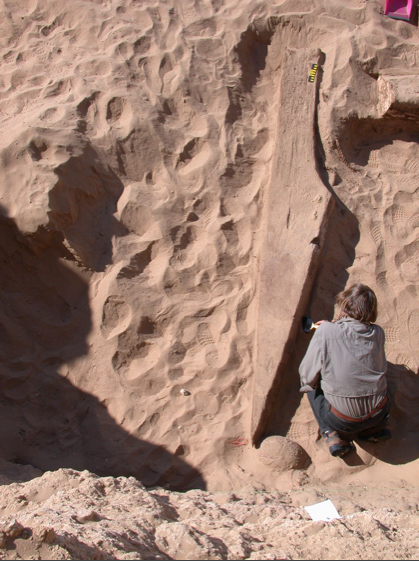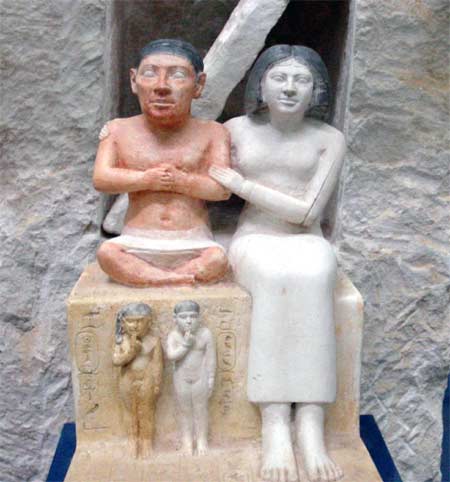Egyptian Museum
King Tut Red
 The
discovery of jars of wine in King
Tuts tomb prompted a team of Spanish scientists to try and
determine if the boy king preferred red or white
wine. An analysis of residues in 2005 revealed that the jars contained syringic
acid, which implied that the wine was made with red grapes.
The
discovery of jars of wine in King
Tuts tomb prompted a team of Spanish scientists to try and
determine if the boy king preferred red or white
wine. An analysis of residues in 2005 revealed that the jars contained syringic
acid, which implied that the wine was made with red grapes.
Big Toe
 Archeologists
explored a tomb near Thebes in 2005 and discovered an artificial big toe
attached to the foot of a mummy. The fake body part could prove to be the
earliest working prosthetic body part to date.
Archeologists
explored a tomb near Thebes in 2005 and discovered an artificial big toe
attached to the foot of a mummy. The fake body part could prove to be the
earliest working prosthetic body part to date.
Child Mummy
 The
mummified remains of an Egyptian 6-year-old sat in the attic of its owners
before being donated to the St. Louis Science Center in 1985. Researchers at the
center have used CT scan technology to help unravel the mystery of its origins.
The
mummified remains of an Egyptian 6-year-old sat in the attic of its owners
before being donated to the St. Louis Science Center in 1985. Researchers at the
center have used CT scan technology to help unravel the mystery of its origins.
Queen Mummy
 Authorities
in Cairo announced in July of 2007 that the remains of a mummy discovered in the
Valley of the Kings, was that of Queen Hatshpsut, a female pharaoh that ruled in
the 15th century. DNA analysis was used to identify the first royal Egyptian
mummy since King Tut in 1922.
Authorities
in Cairo announced in July of 2007 that the remains of a mummy discovered in the
Valley of the Kings, was that of Queen Hatshpsut, a female pharaoh that ruled in
the 15th century. DNA analysis was used to identify the first royal Egyptian
mummy since King Tut in 1922.
Dwarf Statue
 This
statue was erected in honor of Seneb, an Egyptian dwarf who served under King
Pepi II during the 6th Dynasty. A study published in December of 2005 concluded
that dwarves, such as Seneb, were respected and even attained high positions in
society.
This
statue was erected in honor of Seneb, an Egyptian dwarf who served under King
Pepi II during the 6th Dynasty. A study published in December of 2005 concluded
that dwarves, such as Seneb, were respected and even attained high positions in
society.
Preserved Ship
 Archeologists
announced in March of 2006 that an excavation near the Red Sea had unearthed a
shipyard containing the world's oldest sea-faring ships. The artifacts, such as
wooden planks and cargo boxes, suggest that Egyptians had set sail 4,000 years
ago.
Archeologists
announced in March of 2006 that an excavation near the Red Sea had unearthed a
shipyard containing the world's oldest sea-faring ships. The artifacts, such as
wooden planks and cargo boxes, suggest that Egyptians had set sail 4,000 years
ago.
Lost City
 Satellites
have located and zoomed in on a 1,600-year-old Egyptian city. Snapshots of the
site taken from space as part of a project to map as much of ancient Egypt's
archaeological sites, or "tells," as possible were released in July of 2007.
Satellites
have located and zoomed in on a 1,600-year-old Egyptian city. Snapshots of the
site taken from space as part of a project to map as much of ancient Egypt's
archaeological sites, or "tells," as possible were released in July of 2007.
Sand Sea
 The
Great Sand Sea in the Eastern Sahara is currently nothing more than 45,000
square miles of desert land. But a climate study published in July of 2006,
suggests that monsoon rains that occurred around over 10 millennia ago made it
very hospitable for humans and wildlife.
The
Great Sand Sea in the Eastern Sahara is currently nothing more than 45,000
square miles of desert land. But a climate study published in July of 2006,
suggests that monsoon rains that occurred around over 10 millennia ago made it
very hospitable for humans and wildlife.
Ancient Frolicking
 Ancient
artistic depictions of swimming activities discovered inside a cave is evidence
that people living in southwest Egypt once frolicked in rain pools 8,000 years
ago. This was before monsoon rains ended and left the Sahara uninhabitable.
Ancient
artistic depictions of swimming activities discovered inside a cave is evidence
that people living in southwest Egypt once frolicked in rain pools 8,000 years
ago. This was before monsoon rains ended and left the Sahara uninhabitable.
Best Mummies?
 Archeologists
exploring a 2,500 year old Egyptian tomb in 2005 found three intricate coffins,
with one containing an amazingly well-preserved mummy. One of the archeologists
called it perhaps "one of the best mummies ever preserved."
Archeologists
exploring a 2,500 year old Egyptian tomb in 2005 found three intricate coffins,
with one containing an amazingly well-preserved mummy. One of the archeologists
called it perhaps "one of the best mummies ever preserved."
Gimme!
 Claiming
that many of their artifacts were taken from Egypt illegally, Egyptian officials
announced in April of 2007 that it would ask museums abroad to temporarily send
back some of its most precious artifacts including the Rosetta Stone and bust of
Nefertiti.
Claiming
that many of their artifacts were taken from Egypt illegally, Egyptian officials
announced in April of 2007 that it would ask museums abroad to temporarily send
back some of its most precious artifacts including the Rosetta Stone and bust of
Nefertiti.
Pyramid Secrets Revealed
 Evidence
has been offered to suggest that some of the stone blocks used to construct the
Great Pyramids of Giza were cast—not carved and then quarried, as some had
thought. An examination of the stones revealed that the outer and inner casing
stones were unlikely to have been chiseled from natural limestone.
Evidence
has been offered to suggest that some of the stone blocks used to construct the
Great Pyramids of Giza were cast—not carved and then quarried, as some had
thought. An examination of the stones revealed that the outer and inner casing
stones were unlikely to have been chiseled from natural limestone.
King Tut
 Forensic
scientists and artists completed in 2005 the first ever facial reconstructions
of King Tut using CT scans of his mummified remains. The pharaoh's reconstructed
facial composition turned out to be strikingly similar to ancient portraits of
Tut.
Forensic
scientists and artists completed in 2005 the first ever facial reconstructions
of King Tut using CT scans of his mummified remains. The pharaoh's reconstructed
facial composition turned out to be strikingly similar to ancient portraits of
Tut.
 The
discovery of jars of wine in King
Tuts tomb prompted a team of Spanish scientists to try and
determine if the boy king preferred red or white
wine. An analysis of residues in 2005 revealed that the jars contained syringic
acid, which implied that the wine was made with red grapes.
The
discovery of jars of wine in King
Tuts tomb prompted a team of Spanish scientists to try and
determine if the boy king preferred red or white
wine. An analysis of residues in 2005 revealed that the jars contained syringic
acid, which implied that the wine was made with red grapes.






